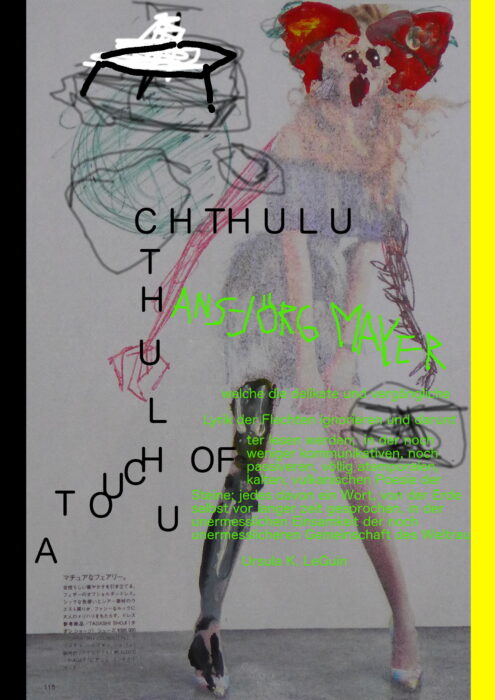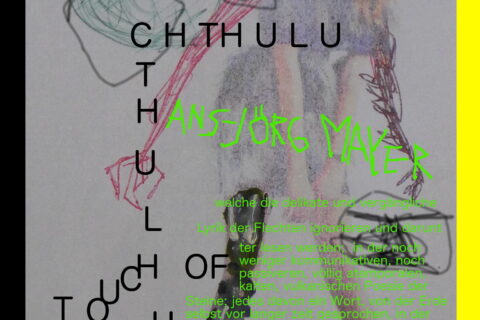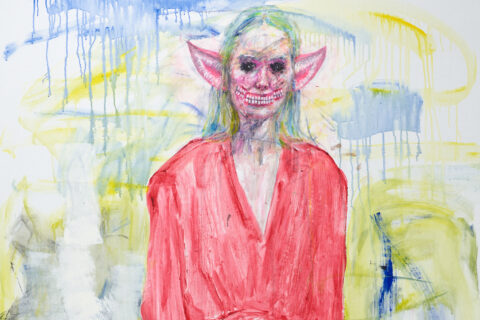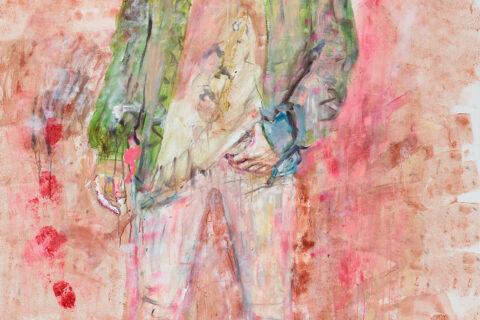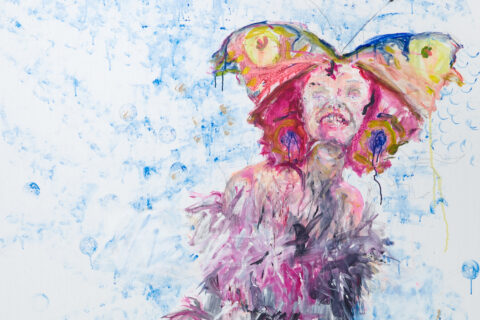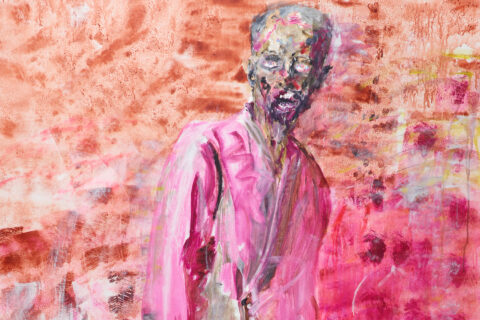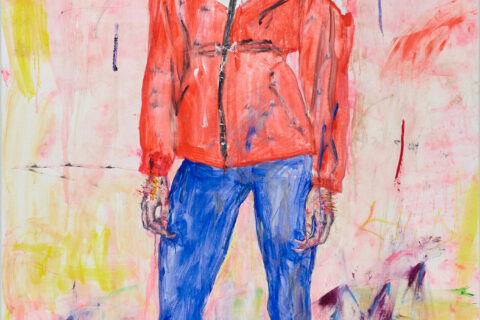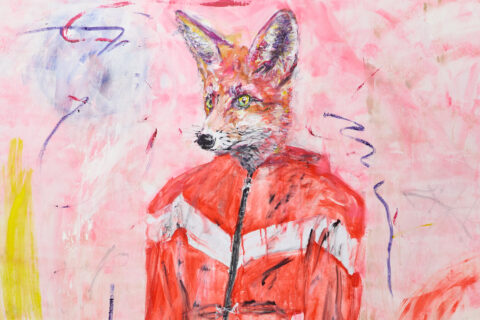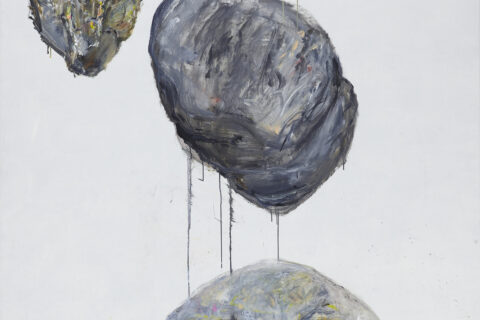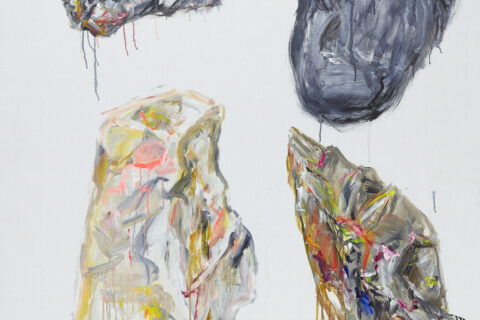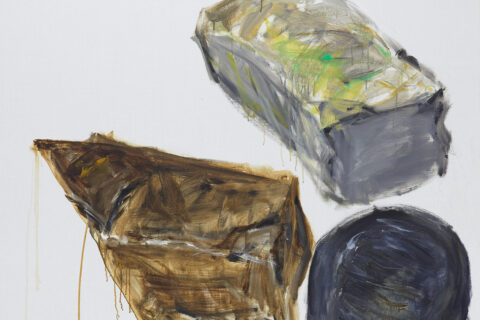Hans-Jörg Mayer A Touch of Chtuhlu
19/11/2020 – 09/01/2021
Galerie Nagel Draxler
Elisenstraße 4–6
50667 Cologne
Öffnungszeiten / Hours:
Mittwoch bis Freitag, 11-18 Uhr & Samstag, 11-16 Uhr
(ausgenommen sind Feiertage)
Wednesday to Friday, 11am-6pm & Saturday, 11am-4pm
(excluding public holidays)
und nach Vereinbarung / and by appointment: koeln@nagel-draxler.de
Besondere Öffnungszeiten / special opening hours
Samstag, 12. Dezember 2020, 11 – 21 Uhr
Saturday, December 12th, 2020, 11 am – 9 pm
Winterpause / Winter break:
19. Dezember 2020 – 5. Januar 2021
December 19th, 2020 – January 5th, 2021
Press Release
**scroll down for english version**
A Touch of Cthulhu [1]
„Zombies werden oft als Konsumidioten interpretiert. Zombies sind die, gegen die diejenigen, die es sich leisten können, Mauern errichten, hinter denen sie sich verschanzen. Weil Zombies kollektiv agieren, überwinden sie letztlich alle Hindernisse. Durch technische und gentechnische Modifizierungen entwickeln sie sich weiter zu Cyborgs und Tier-Mensch Wesen, eine neue Spezies. Irgendwann brechen sie in den Weltraum auf.“ HJM
Die kulturell vermittelten Grenzziehungen zwischen Tier, Mensch und Maschine sind im Zeitalter der Gen- und Informationstechnologie fluider geworden. Bereits in den 1980ern begründete Donna Haraway mit Ihrem Jahrhundert-Essay „Manifest für Cyborgs“ einen neuen, feministisch geprägten, emanzipatorischen Mythos der „Neuerfindung der Natur“, der sich die Wunder der Techno- und Scienceavantgarde aneignet, statt sie als männlich dominiert zurückzuweisen. In diesem Zusammenhang ist auch der extrem kreative Output an futuristisch inszenierter Ästhetik in Film, Mode, Literatur und Musik des Undergrounds der 80er Jahre zu sehen.
All dies fand in einer noch weitgehend analogen Welt statt. Was damals noch sehr viel schöne Fantasie war, ist heute Alltag, nur nicht so schön. Der Fortschritt ist bekanntlich nicht aufzuhalten, aber schon immer verstört er auch die Menschen und macht ihnen Angst, wie alles Fremde. Begeisterung und Abwehr existieren parallel seit der Entdeckung des Feuers.
Hans-Jörg Mayer malt Zombies, die aussehen wie Models, Cyborg Frauen mit Techno-Prothesen und perfekt gekleidete Mensch-Tier Wesen. Und Steine, möglicherweise Millionen von Jahren alt, die aussehen wie Steine. Sein Repertoire streift dabei natürlich die ästhetische Exzentrik der 80er Jahre, in die der Beginn seiner künstlerischen Arbeit fällt, aber auch die früh-feministisch geprägte Kunstwelt der Sci-Fi Literatur der 20er-50er Jahre. Nicht aus Nostalgie, sondern zur Feier der emanzipatorischen Kraft des Andersartigen, die in diesen epochalen Nischen wuchert und die Utopie eines nicht anthropozentrisch geprägten Weltbilds speist.
Trotz hemmungsloser freiwilliger Technologietransplantation in alle Lebensbereiche regiert dagegen auch heute in lähmender Weise die Angst, dass immer weniger Mensch (Leben) und immer mehr Maschine (Tod) im Menschen steckt. Leben ist heilig, der Tod amoralisch, wie die Natur. Dabei geht es gar nicht um Moral, sondern um Verteilung. Mensch sein ist Privileg. Zwischen Leben und Tod blüht das Leben.
[1] Call of Cthulhu’ ist eine Geschichte von H.P. Lovecraft von 1926. Lovecraft thematisiert in seinen Geschichten die Bedeutungslosigkeit des Menschen angesichts eines gleichgültigen, unendlichen Kosmos.
__________
A Touch of Cthulhu [1]
“Zombies are often interpreted as consumption idiots. Zombies are those against whom those who can afford it erect walls behind which they entrench themselves. Because zombies act collectively, they ultimately overcome all obstacles. Through technical and genetic modifications, they continue to evolve into cyborgs and animal-human beings, a new species. At some point they set off into space.” HJM
The culturally mediated boundaries between animal, human and machine have become more fluid in the age of genetic and information technology. Already in the 1980s, Donna Haraway founded a new, feminist, emancipatory myth of the “reinvention of nature” with her essay of the century, “Manifesto for Cyborgs”, which appropriated the wonders of the techno and science avant-garde instead of rejecting them as male-dominated. The extremely creative output of futuristically staged aesthetics in film, fashion, literature, and music of the underground of the 1980s should also be seen in this context.
All this took place in a world that was still largely analogous. What was then still a lot of beautiful fantasy is now everyday life, just not so beautiful. As is well known, progress is unstoppable, but it has always disturbed people and frightened them, like everything that is different. Enthusiasm and defense exist parallel since the discovery of fire.
Hans-Jörg Mayer paints zombies that look like models, cyborg women with techno prostheses and perfectly dressed human-animal beings. And stones, possibly millions of years old, that look like stones. His repertoire naturally touches the aesthetic eccentricity of the 1980s, in which the beginning of his artistic work falls, but also the early feminist artistic world of Sci-Fi literature of the 1920s and 1950s. Not out of nostalgia, but in celebration of the emancipatory power of the different, which is rampant in these epochal niches and feeds the utopia of a non-anthropocentric world view.
Despite the unrestrained voluntary transplantation of technology into all areas of life, the fear that there is less and less human (life) and more and more machine (death) in the human being still reigns in a paralyzing way today. Life is sacred, death is amoral, just like nature. But it is not at all about morality, but about distribution. Being human is a privilege. Between life and death, life flourishes.
[1] Call of Cthulhu’ is a story by H.P. Lovecraft from 1926. In his stories Lovecraft thematizes the insignificance of man in the face of an indifferent, infinite cosmos.
